|
Adam Chodzko on 'The Dark Monarch',
conceptual art and the nature of place
interview by Rupert White
'The Dark Monarch' is a very
interesting show I'm sure you'd agree. What are your impressions? How do
you feel about the themes it explores?
I think its extraordinary, very
diverse. There's stuff that's been completed in the last few hours
brought into dialogue with works made over 150 years earlier.
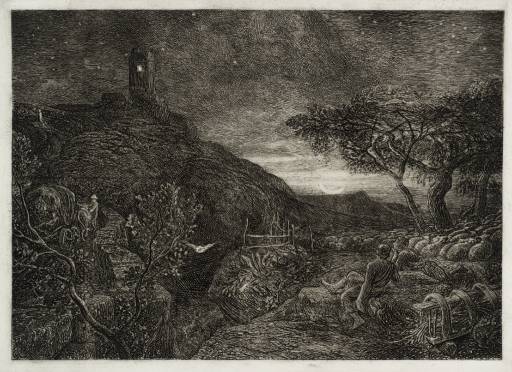 There's
a Paul Nash from 1910, and Richard Dadd and Samuel Palmer (The Lonely
Tower - picture right) from the 19th Century for example... There's
a Paul Nash from 1910, and Richard Dadd and Samuel Palmer (The Lonely
Tower - picture right) from the 19th Century for example...
Its amazing how fresh a lot of that
earlier work looks now. I would not be particularly excited by a Cecil
Collins retrospective in isolation. But they suddenly make sense next to
a John Russell from 2010. And vice versa!
I think all the work looks like its taking
a risk. Most museum shows don’t dare this and instead operate to
reassure and ‘inform’ the viewer by gathering everything within the same
time period or the same artist. Dark Monarch undermines this, looking
instead for a similar sensibility across time; a fascination with the
British Landscape and fascination with the Surreal. In attempting to
address the reality of this landscape a shift occurs into other
realities. And within this movement is an overt or unconscious play of
notions of the magical.
A lot of these artists are not that well
known, but I think they're crucial for an understanding of British art:
someone like Graham Sutherland who remains totally overshadowed by Bacon
for example really is fantastic and, I think, a much more interesting
artist.
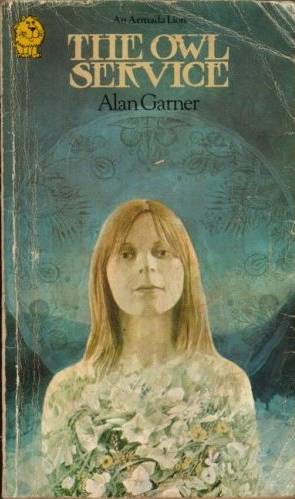 Does
the show feel very British? This is something Michael Bracewell mentioned. Does
the show feel very British? This is something Michael Bracewell mentioned.
Yes. I think it is very British. But, I
guess, what does that “Britishness” mean other than an abstract feeling
that denotes a collective identity. I mean the part of Kent where I live
seems worlds apart in appearance and atmosphere from this part of
Cornwall. And the corner of one particular field is a presence in
contrast to the wall of a new build house two miles way. Each place is
fundamentally different from another and yet we can still speak of
something feeling British.
However, I think more than a record of the
specific yet rich diversity of Britain’s landscape there is a
“Britishness” more apparent in the artist’s response to this context;
that peculiar concoction of sublimated delight and terror, wonder and
pragmatism that is revealed in most British behaviour.
But, I think for Dark Monarch I’ve been
thinking about this response in terms of a whole sphere of TV narratives
about the British landscape in the early 70's. I saw these as a child:
where some kind of apocalyptic (nuclear!) event had happened, creating a
dystopia which catalysed supernatural’s conjecture with the present.
Magic was seen as both the source of disorder and simultaneously a
salvation. It was just corrupted – made ‘dark’ - by human foibles. I'm
thinking of Children of the Stones, The Changes, The Owl Service. These
are all terrifying to watch – very odd, and yet were on TV for children.
There is nothing like them now. The books of Alan Garner (picture
above), John Wyndham and Ballard also work with these themes of course
and they became a big influence on me.
I think this narrative still impacts on
contemporary values and behaviour in Britain.
Talking of influences would you
recognise any of the older artists here as having been influences on
you?
Yes. Graham Sutherland, Peter Lanyon,
Derek Jarman, Paul Nash, and then younger ones like John Stezaker...
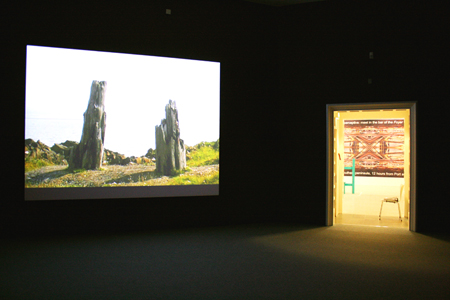 It's
interesting looking at the modernist work to consider how the conceptual
processes involved with making art have changed in the last 40 years.
Conceptual art happened in the 60s and 70s and that changed things
didn't it? It's
interesting looking at the modernist work to consider how the conceptual
processes involved with making art have changed in the last 40 years.
Conceptual art happened in the 60s and 70s and that changed things
didn't it?
I think it did. And changing
technology, shifting value systems...
I think what's quite interesting is
that, apart from Derek Jarman, there isn't any video-work. The curators
have concentrated on objects that form the iconography of the Occult.
There's a whole other sphere of stuff – time based work - that hasn't
been included. There were lots of works of mine that were being
discussed by the curators that deal with a real engagement of magic
within a relational context - something that Martin Clark calls
‘operational’ work. But they decided not to include this. So ‘Dark
Monarch’ focuses more on the iconography of magic’s interface with
landscape, although artists like Austin Osman Spare were clearly
practitioners.
Some of the works that were in my solo
show here - like 'Plan for a Spell' (video projection -
installation view) for instance which is very much about a complex
conceptual process; a movement of the British landscape, an embedded
spell, a narrative about how some kind of system of coincidence and
chance playing itself out. And going back to your question about
conceptualism – “Plan for a Spell” is very much a meeting of
conceptualism and the surreal.
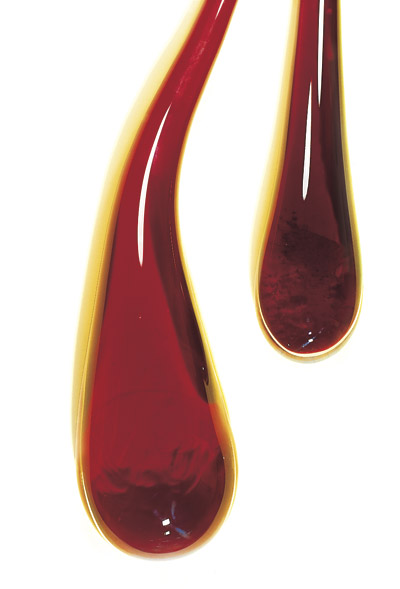 In
many ways the best conceptual art is very mystical or magical. It's not
necessarily as dry as some people imagine. In
many ways the best conceptual art is very mystical or magical. It's not
necessarily as dry as some people imagine.
It can be deeply romantic, with a sense
of longing and desire embedded within it. Which is different from a lot
of the first generation conceptual art which was more of a
pseudo-sociology, and about systems of engagement. But even within that
was often an inherent folksiness that we tend to iron out.
In your own work there are forms
of magical thinking. Either bold imaginary and conceptual leaps between
different ideas and people and places, or a slower, perverse aleatory
logic.
I’m trying to work as much as possible
with a surreal that leaks out of the everyday reality that we live with
and often become quite blind to. Its about seeing it as rich and full of
potential.
Seeing the magic in the
ordinary...
About that, and chance and coincidence
remain an absolute mystery in our normal lives, because we develop these
very rational and controlled ways of dealing with them.
This strand has been present in
your work from the beginning. Some of your
early pieces, for example, insert fictional futuristic or magical
elements into quite ordinary situations. I'm thinking here of the
'Secretors' with their 'manifestation juice' which feature in The Dark
Monarch (picture above) or the advert in Loot for 'Millenarian
heterogenous apparition' for example (picture below).
I think, going back to what we saying about those narratives within
British Culture in the early seventies – these works are always about
being in a seemingly very stable context and then noticing that system
is about to collapse allowing something else to leak through.
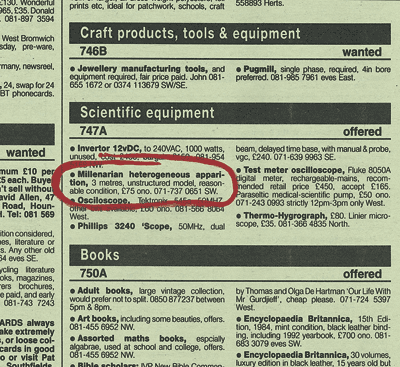 You
mention film, and thinking of Derek Jarman, there is something about
film that is inherently Romantic and magical. Jarman himself talked of
the alchemy of film. It lends itself to rich iconography and lush
textures... You
mention film, and thinking of Derek Jarman, there is something about
film that is inherently Romantic and magical. Jarman himself talked of
the alchemy of film. It lends itself to rich iconography and lush
textures...
Yes. Also magic has a performative and
ritualistic component. And you'd think film would be a crucial part of
that. Its referred to I think though within a lot of the 2D and 3D work
in the show. And of course Cerith Wyn Evans started out as a film-maker
influenced by Jarman and Anger.
The themes of the show are so
rich that it has clearly been hard to cover everything. Its interesting
that there's also no Land Art in the show, and I do think of Richard
Long as being at least related to this tradition, though not at all
gothic.
Yes. That’s true.
There's some Land Art in your
work too. Such as the signposts project 'Better Scenery' (pictures X2
below), and maybe 'Test tone for a Landscape'. A geographic component
remains important.
What seems important to the mysticism
of the British Landscape and its mediation through art is that
particular places are held to be absolutely crucial. In a lot of the
works, Nash and Sutherland there are references to specific place.
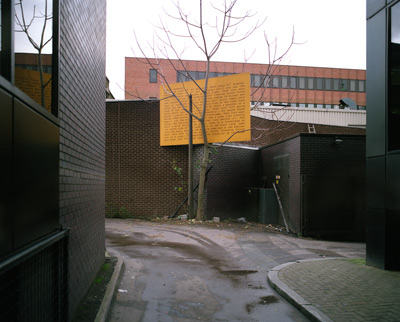 Talking
of place at a more personal level, you're someone who lived in London
for a long time, but who moved to Kent more recently. Artists in
Cornwall are very conscious of where they live and work - how does
living out of London affect your practice? Talking
of place at a more personal level, you're someone who lived in London
for a long time, but who moved to Kent more recently. Artists in
Cornwall are very conscious of where they live and work - how does
living out of London affect your practice?
Well, beyond the immediate contact with
landscape and a micro-community that it provides a lot of practical
things are also made easier living out of the city. London is terrible
for making work because everything is so dispersed so picking up
materials can take ages. That's your day gone. Where I am now you can
get things made very easily because the environment does not have that
congestion. There is a chaos in London, a noisiness and busyness, and
its difficult to get clarity, so it helps with that.
So there's more headspace?
Yes. Now I only go into London if I
really need to. And now I quite like it. I’m like a tourist and I get
lost. I’ve forgotten the rules. Friends of mine who are outside the art
world have this perception that this sphere of activity is full of wild,
experimental and exploratory people, but actually in many ways it’s
deeply conservative and fearful of drifting away from a very familiar
and solid centre; literally and metaphorically. I remember when I was in
South London it was almost impossible to get anyone from North London to
travel to visit my studio or galleries in south london. It was felt to
be too far away!
I think the economics of studio space
and living space means that now all over Britain you have far more
artists staying on in eg: Manchester, Sheffield, Nottingham - even near
me in Folkestone and Margate are artist run spaces putting on
interesting shows.
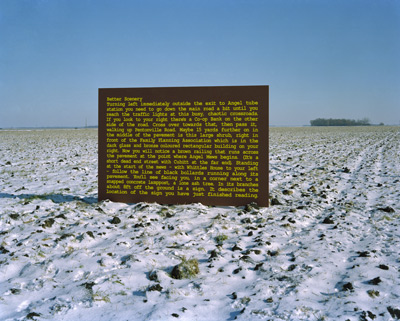 That's
changed in the last ten years? That's
changed in the last ten years?
Yes and some curators are much more
aware of it. A lot of ‘London based’ artists in the show actually are
pretty far out into what 10 years ago would have been considered outer
suburbs. Clare Woods who is in the show now lives in Herefordshire.
Linder is in Morecombe. A lot of interesting art is made away from the
centre...
More diverse, made for different
audiences perhaps...
And more idiosyncratic because it's
away from a constant chatter. It’s not being made on top of a whole load
of other people who are making very similar work, too acutely aware of
the market. It’s good for the work to become oblivious of the market.
|

 There's
a Paul Nash from 1910, and Richard Dadd and Samuel Palmer (The Lonely
Tower - picture right) from the 19th Century for example...
There's
a Paul Nash from 1910, and Richard Dadd and Samuel Palmer (The Lonely
Tower - picture right) from the 19th Century for example... Does
the show feel very British? This is something Michael Bracewell mentioned.
Does
the show feel very British? This is something Michael Bracewell mentioned. It's
interesting looking at the modernist work to consider how the conceptual
processes involved with making art have changed in the last 40 years.
Conceptual art happened in the 60s and 70s and that changed things
didn't it?
It's
interesting looking at the modernist work to consider how the conceptual
processes involved with making art have changed in the last 40 years.
Conceptual art happened in the 60s and 70s and that changed things
didn't it?  In
many ways the best conceptual art is very mystical or magical. It's not
necessarily as dry as some people imagine.
In
many ways the best conceptual art is very mystical or magical. It's not
necessarily as dry as some people imagine. You
mention film, and thinking of Derek Jarman, there is something about
film that is inherently Romantic and magical. Jarman himself talked of
the alchemy of film. It lends itself to rich iconography and lush
textures...
You
mention film, and thinking of Derek Jarman, there is something about
film that is inherently Romantic and magical. Jarman himself talked of
the alchemy of film. It lends itself to rich iconography and lush
textures... Talking
of place at a more personal level, you're someone who lived in London
for a long time, but who moved to Kent more recently. Artists in
Cornwall are very conscious of where they live and work - how does
living out of London affect your practice?
Talking
of place at a more personal level, you're someone who lived in London
for a long time, but who moved to Kent more recently. Artists in
Cornwall are very conscious of where they live and work - how does
living out of London affect your practice? That's
changed in the last ten years?
That's
changed in the last ten years?